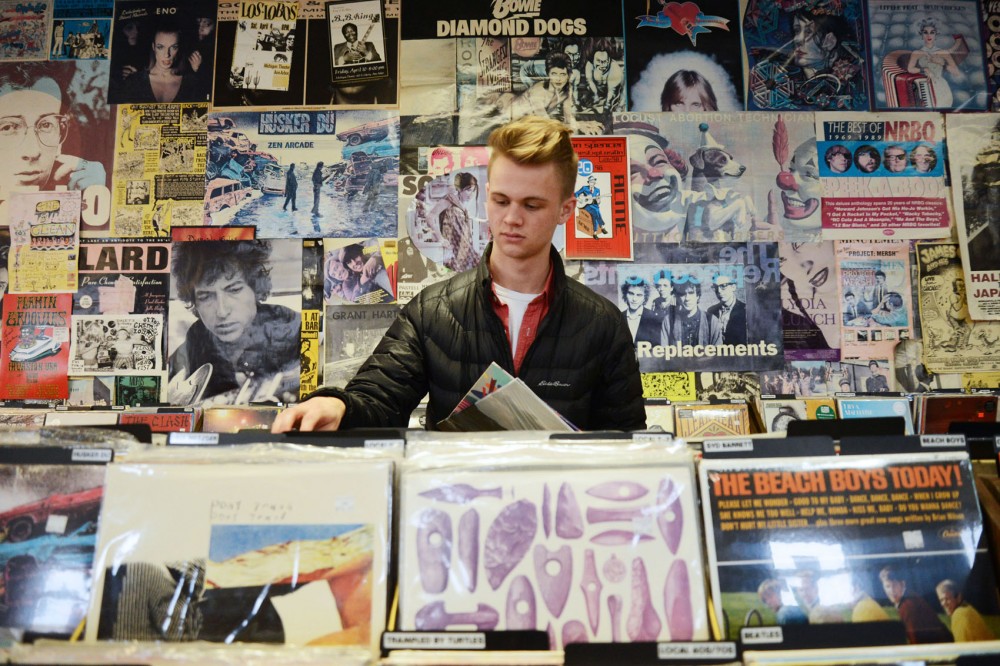The national resurgence of vinyl records have led to skyrocketing sales in recent years, and the trend shows no signs of dying out.
With that, the pressure is on for manufacturers and record labels to keep up with the consumers’ demand.
Record sales increased by 52 percent in 2014, according to a Nielsen music report.
“There’s constrained supply on the manufacturing side for vinyl, so more people want it than can get it [manufactured],” said Andrew Volna, a University of Minnesota history graduate and owner of boutique production house Noiseland Industries.
Noiseland has been operating on a national level for the last 20 years, and its focus has turned from CDs to vinyl records in the past five years, Volna said.
Years ago, French manufacturing plant MPO International had no knowledge of the vinyl resurgence in the United States, and the plant was on the verge of closing its vinyl production. But since Volna initiated a partnership with MPO, vinyl has become a mainstay in the company’s business, he said. Last year it pressed approximately one million records.
Still, the slow production of vinyl records is an unresolved issue.
In a day, one press may produce just 2,000 records compared to 50,000 compact discs, Volna said. The manually assembled product requires more time.
“The people who make them are craftspeople. It’s like building Coach handbags by hand, one at a time,” Volna said.
The slow production time has gotten even slower with the heightened demand of records, especially around peak release times, said Drew Christopherson, co-founder of local record label Totally Gross National Product.
“It’s been a challenge to balance the lengthy production time for vinyl and the immediacy of digital,” Christopherson said.
The label limits the majority of its production to vinyl and digital downloads only, Christopherson said.
“Generally, people see the digital presentation as a way to help fund and promote the physical record,” Christopherson said. “Including downloads with vinyl has surely helped push vinyl into the resurgence it is seeing today. … There are many artists that aren’t that concerned about holding their record in their hands, and there are artists who are motivated by that alone,” he said.
Sales at Minneapolis’ Treehouse Records are at least 95 percent vinyl, the store’s manager Dan Cote said.
“I think enough time has gone by where we can say that it’s not just a fad. People want to have that real experience of dropping the needle and also getting a sound that you cannot replicate with compressed digital files,” Cote said.
Although Treehouse is optimistic about record sales, the price of vinyl could be a concern in the future.
“More and more stuff keeps coming out, and it keeps getting more and more expensive. There could be a point where over-saturation and pricing just kind of kills it off,” Cote said. “I don’t think that’s going to happen any point in the near future, but I could see the bubble bursting at some point.”
Extreme Noise, a volunteer-run record store consisting mainly of punk and metal music, has sold almost exclusively vinyl records for the last 20 years.
“As far as punk music goes, vinyl never went out of fashion at all,” Kai Bosworth, a volunteer at Extreme Noise and University geography graduate student said. “When I was growing up I had to get into vinyl because there were songs I wanted to hear that I couldn’t hear on any other format.”
The vinyl resurgence helped Extreme Noise stay in business after a major decline in CD and vinyl sales in 2007.
“I think part of it is wanting to support artists and musicians; part of it is wanting to have the art and lyrics and all that kind of stuff,” Bosworth said. “There is also kind of a collector culture around it, too.”
Vinyl listener Travis Turner, who spends about $80 a week on records, said he got into vinyl as a college radio DJ at Macalester College. For him, it was about the scratchy sound, the act of searching for a record and the album artwork.
“I have a record that I’m going to put up on the wall that is pretty much not for the music at all. It’s got a sweet dragon picture on it,” Turner said. “It’s from this Australian bar band from the ‘70s — they’re OK, but the record cover is just so kick-ass.”
Psychology and communications senior Jamie White said she has been listening to vinyl for the last three years. To keep from breaking a college student budget, she said the trick is to be selective.
“You have to solidify which artists you really like a lot,” White said.








